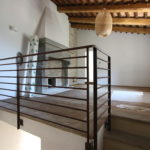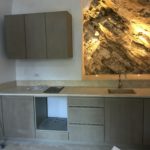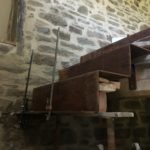The refurbishment is now completed, only furniture is missing. It has been a challenging job due to the extremely difficult access which resulted in having to use special small machinery and often hand transportation for building material. But we managed to turn this small dwelling into a cosy retreat, to enjoy both in summer and winter. Warm oak floors (first floor) and travertine slabs (ground floor) meet the harsh stone medieval walls – the restoration has respected the original aspects of the building, but at the same time it has provided modern comfort, with underfloor heating and high-performing windows.
Farmhouse restoration in Umbria (near Gubbio), completed
The restoration is finally completed and the owners last summer started to enjoy their italian retreat. Plenty of light, modern interior, but also a strong presence of the original stone building – an old, abandoned farmhouse which has now a new life.
Renovation in Umbria: internal stairs
One of the recurrent issue when restoring an old farmhouse is where to locate the internal stairs and what material to use. These houses had in fact the two storeys completely separate, the ground floor as stables for animals and the upper floor for the people, with no internal connection but only an external – usually beautiful – staircase.
So, when renovating the ground floor we need to insert new stairs. In order to save space and achieve lightness, I like to insert slender metal stairs, often in cor-ten (rusty metal) a material that integrate itself beautifully with the old, existing materials, such as stone, brick, timber of traditional umbrian farmhouses. Some of the pictures show a staircase being mounted and other example of a completed job. A renovation in Umbria by architect Marco Carlini




































